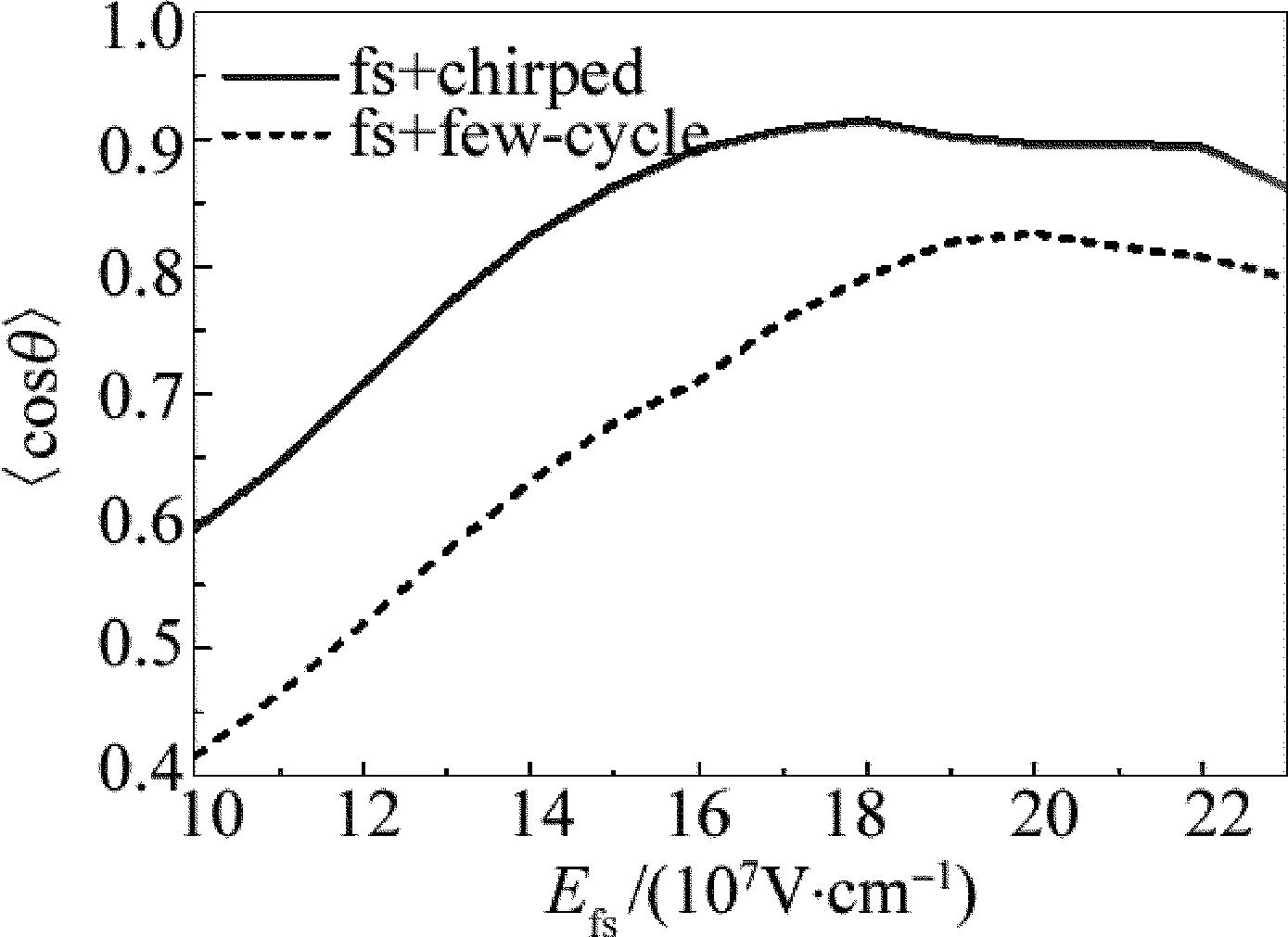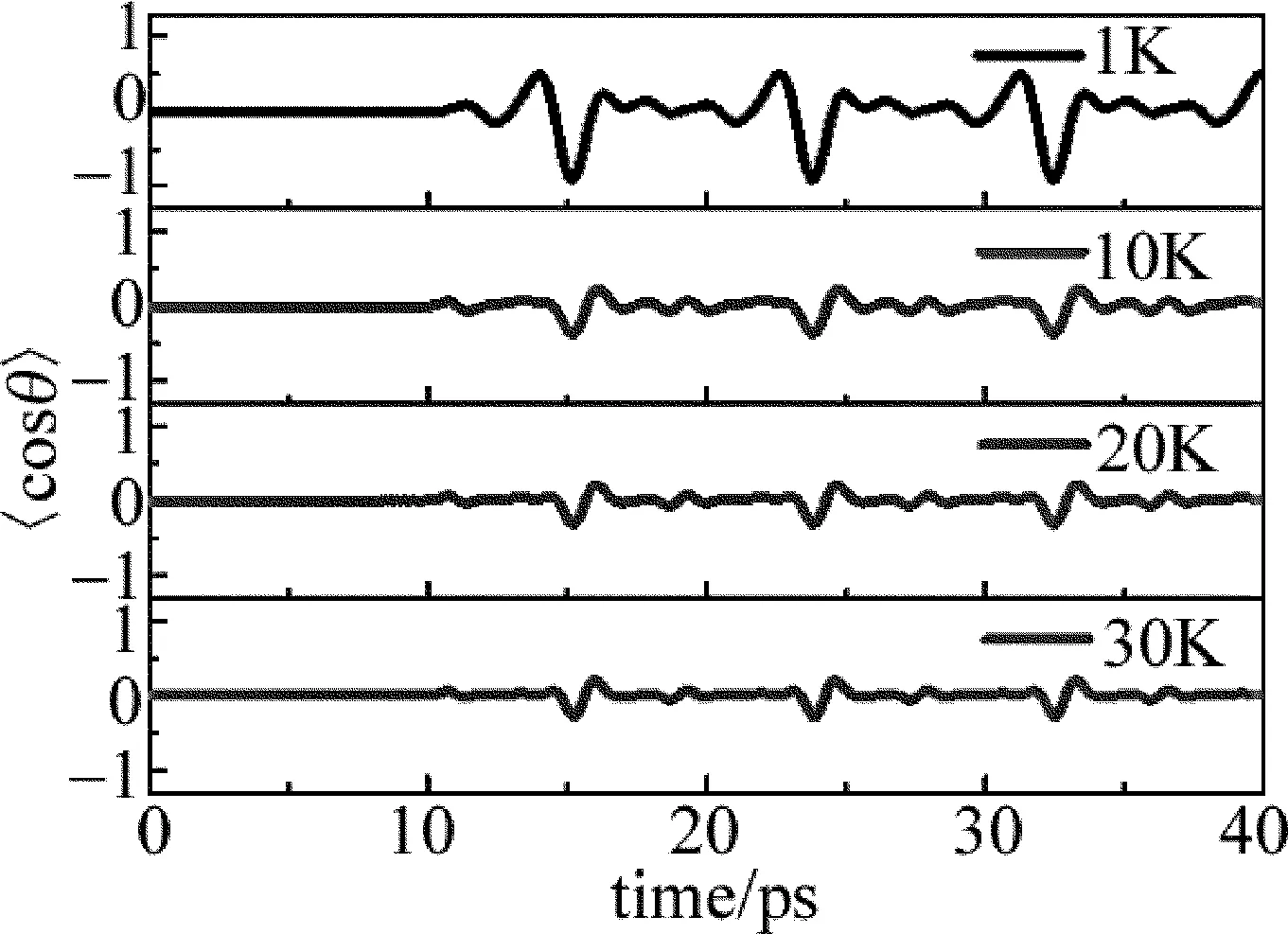飞秒激光结合啁啾太赫兹脉冲控制CO分子取向
2015-03-22杨明惠刘劲松王可嘉杨振刚
杨明惠,金 琪,刘劲松,王可嘉,杨振刚
(华中科技大学 武汉光电国家实验室,武汉430074)
飞秒激光结合啁啾太赫兹脉冲控制CO分子取向
杨明惠,金琪,刘劲松,王可嘉*,杨振刚
(华中科技大学 武汉光电国家实验室,武汉430074)
摘要:为了研究啁啾太赫兹脉冲诱导后的CO分子取向,采用刚性转子近似求解含时薛定谔方程的方法,进行了理论分析和数值仿真。为了在较低太赫兹场强时获得较好的取向效果,采用了飞秒激光结合啁啾太赫兹脉冲的方案。结果表明,分子取向程度可增强81%。在有限温度条件下,飞秒激光结合啁啾太赫兹脉冲诱导分子取向的效率随温度的升高而降低;相对于少周期太赫兹脉冲,啁啾太赫兹脉冲有诱导分子取向的优越性。这一结果对提高CO分子取向程度是有意义的。
关键词:激光物理;分子取向;刚性转子模型;啁啾太赫兹脉冲
*通讯联系人。E-mail: wkjtode@sina.com
引言
分子的各向异性和空间分布在许多物理及化学过程中起着重要作用,如高次谐波产生[1]、化学反应动力学[2]、光电离及解离[3-4]、超快分子成像[5-6]等。近年来,控制分子的准直及取向引起了人们的广泛关注。分子的准直指的是分子轴沿着某一固定的坐标轴,如激光场的偏振方向。而分子的取向指的是在准直的基础上控制分子指向固定的方向,这就意味着要打破分子的反演对称性,因而分子取向的实现要比准直更加困难。

作者以CO气体为例,研究了利用啁啾太赫兹脉冲来控制大转动周期分子气体的取向,通过对比少周期太赫兹脉冲,理论上证明了啁啾太赫兹脉冲的优越性。为了能够在啁啾太赫兹脉冲场强较低的情况下得到大转动周期的气体分子较高的取向,采用了飞秒激光结合啁啾太赫兹脉冲的方法来控制分子取向,即先利用飞秒激光预激发气体分子,在适当的延时后分子再与啁啾太赫兹脉冲相互作用,发现可增强CO分子取向程度大约81%。最后研究了温度对飞秒激光结合啁啾太赫兹脉冲诱导分子取向的影响。该方案从理论上证明了飞秒激光结合啁啾太赫兹脉冲可增强CO气体的分子取向程度,可望用于利用低场强的啁啾太赫兹脉冲控制大转动周期分子气体的化学反应及光电离、解离等过程。
1理论方法
由Born-Oppenheimer近似,气体分子与线偏振场相互作用,分子转动波函数ψ(t)的时间演变可由含时薛定谔方程求出:
(1)

作者采用刚性转子近似[21],即只需考虑分子转动自由度,忽略其它自由度的影响。因而,线偏振的太赫兹脉冲及飞秒激光脉冲与分子相互作用的哈密顿量[19]可以写为:
(2)
(3)

接下来,用自由空间中刚性转子的本征函数球谐函数球谐函数YJ,M(θ,φ)(φ为球坐标系下的方位角)展开转动波函数[22]:
(4)
式中,Jmax设为一个较大值,大于脉冲可激发分子至的最高转动态,CJ,M(t)为布居系数,EJ表示J转动态的本征能量,J为转动态能级的角量子数,M表示角动量在激光(或太赫兹)场偏振方向上的投影,对于线偏振的激光场,M保持不变,即ΔM=0。由于仿真环境温度为0K,此时分子初态处于转动基态,即M恒等于0。
将(2)式、(3)式、(4)式带入(1)式,可以得到一个关于CJ,M(t)的微分方程组。采用4阶Runge-Kutta法可以求出CJ,M(t)随时间的变化,进而可以表示出分子的转动波函数ψ(t)。
分子取向程度可由cosθ的期望值表示:

(5)
式中,*表示共轭,′表示J和Jmax不同的取值。
2结果与讨论
2.1 利用啁啾或少周期太赫兹脉冲诱导分子取向的比较
啁啾太赫兹脉冲电场表达式可写为[20]:
(6)
式中,τ表示啁啾太赫兹场的半峰全宽(full width at half maximum,FWHM),啁啾太赫兹脉冲频率随时间变化,ω为中心时刻tp时的角频率,χ为线性啁啾率,E0表示太赫兹脉冲峰值场强。
少周期太赫兹脉冲[17]由于电场不对称性很强,因而其与分子作用后可以得到很大的取向值,作为参照,选取同样参量下的少周期太赫兹脉冲与啁啾太赫兹脉冲进行对比。
图1为啁啾太赫兹脉冲与少周期太赫兹脉冲的时域及频域的对比图。其中τchirped=τfew-cycle=500fs,ωchirped=ωfew-cycle=2πTHz,χ=1.014×1025s-2,中心时刻tp=0ps。

Fig.1a—time-dependent electric field of chirped terahertz pulse and few-cycle pulseb—frequency distribution of chirped terahertz pulse and few-cycle pulse
由于太赫兹脉冲频率与CO分子转动跃迁频率接近,因而它们的相互作用属于共振激发,分子随着太赫兹场强的变化而加速或减速转动。由图1b可以看出,相比而言,啁啾太赫兹脉冲在0.6THz以下及1.7THz以上的频率分量较多,而少周期太赫兹脉冲在0.6THz~1.7THz之间的频率分量较多。而小于0.6THz的频率分量对应的正好是CO分子转动态能级的角量子数J=4以下的跃迁过程。同样的电场强度下,由于啁啾太赫兹脉冲的低频分量(0THz~0.6THz)更多,因而能更大程度地激发转动基态及低转动态跃迁,而少周期太赫兹脉冲即便高频分量(0.6THz~1.7THz)更多,但由于低频分量较少,不能够有效激发转动基态及低转动态跃迁至高转动态,实现转动态布居的有效转移,因而不易得到高取向程度。



图3a和图3b分别为1×107V/cm,6.6×107V/cm电场下,少周期太赫兹脉冲及啁啾太赫兹脉冲与分子相互作用后的转动态布居图。1×107V/cm场强下,啁啾太赫兹脉冲可以把分子激发至J=2转动态,而少周期太赫兹脉冲只能激发分子至J=1转动态,6.6×107V/cm场强下,啁啾太赫兹脉冲可以把分子激发至J=11转动态,而少周期太赫兹脉冲只能激发分子至J=7转动态。

Fig.3Rotational population of the oriented CO molecules when chirped terahertz pulse or few-cycle pulse
a—peak amplitude of 1×107V/cmb—peak amplitude of 6.6×107V/cm

2.2 飞秒激光结合啁啾太赫兹脉冲诱导CO分子取向
尽管单独的啁啾太赫兹脉冲能够取得较高的取向值,但需要非常高的场强(108V/cm量级),为了便于实现,需要在相对较低场强时就能够得到较大的取向值,因而采用了飞秒激光预激发,在适当的延时τ2后加入啁啾太赫兹脉冲,以期增强分子取向程度。


Fig.4Time-dependant orientation degree of CO molecules induced by chirped terahertz pulse in combination with femtosecond laser pulse
图5为分子分别与啁啾太赫兹脉冲或飞秒激光结合啁啾太赫兹脉冲相互作用后的转动态布居对比图。取向程度的增强原因同飞秒激光结合其它类型太赫兹脉冲类似。先由飞秒激光非共振激发分子至更高的转动态,使分子共振跃迁频率更接近太赫兹脉冲频率,再由啁啾太赫兹脉冲共振激发分子至相邻的转动态,实现了更多的转动态分布,与此同时通过调节飞秒激光与太赫兹之间的延时控制分子相邻转动态间的相位,最终达到增强分子取向的效果。由图5可以看出,单独的啁啾太赫兹脉冲只能激发分子至转动态J=2,而加入飞秒激光后可以激发分子至转动态J=8,且奇偶转动态的布居为:Podd=0.4962,Peven=0.5038,两者相互接近,符合获得高取向值的特征,与参考文献[22]中描述的一致。

Fig.5Rotational population of oriented CO molecules induced by chirped terahertz pulse or chirped terahertz pulse in combination with a femtosecond laser pulse when the pulses are over


Fig.6Relationship between maximum degrees of CO orientation and peak amplitude of femtosecond laser pulse electric fieldEfs
a—induced by chirped terahertz pulse in combination with femtosecond laser pulseb—induced by few-cycle pulse in combination with femtosecond laser pulse
2.3 有限温度下的分子取向
在前两节中,作者假定分子转动温度为0K,然而在现实实验中,分子是处在有限温度下的,分子转动态布居应满足Boltzmann分布。取向程度〈cosθ〉可以写成如下形式[22]:

(7)
式中,kB为玻尔兹曼常数,gJ为分子自旋简并系数,Q为配分函数:
(8)


Fig.7Time-dependant orientation degrees for CO molecules at different rotational temperatures
3结论

参考文献
[1]STAPELFELDT H, SEIDEMAN T. Colloquium: aligning molecules with strong laser pulses[J]. Reviews of Modern Physics, 2003, 75(2): 543-557.
[2]HERSCHACH D. Chemical physics: molecular clouds, clusters, and corrals[J]. Reviews of Modern Physics, 1999, 71(2): S411-S418.
[3]LI H, RAY D, DE S,etal. Orientation dependence of the ionization of CO and NO in an intense femtosecond two-color laser field[J]. Physical Review, 2011, A84(4): 043429.
[4]HANSAN J L, STAPELFELDT H, DIMITROVSKI D,etal. Time-resolved photoelectron angular distributions from strong-field ionization of rotating naphthalene molecules[J]. Physical Review Letters, 2011, 106(7): 073001.
[5]IVANOV M Y, MARANGOS J P. Time-resolved imaging of atomic-scale electron and nuclear dynamics[J]. Journal of Modern Optics, 2007, 54(7):899-903.
[6]WU J, LU P, LIU J,etal. Ultrafast optical imaging by molecular wakes[J]. Applied Physics Letters, 2010, 97(16): 161106.
[7]KRAMER K H, BERNSTEIN R B. Focusing and orientation of symmetric-top molecules with the electric six-pole field[J]. Journal of Chemical Physics, 1965, 42(2): 767-770.
[8]HAIN T D, MOISION R M, CURTISS T J. Hexapole state-selection and orientation of asymmetric top molecules: CH2F2[J]. Journal of Chemical Physics, 1999,111(15): 6797-6806.
[9]FRIEDRICH B, HERSCHBACH D R. Spatial orientation of molecules in strong electric fields and evidence for pendularstates[J]. Nature,1991, 353:412-414.
[10]LOESCH H J, REMSCHEID A. Brute force in molecular reaction dynamics: a novel technique for measuring steric effects[J]. Journal of Chemical Physics, 1990, 93(7): 4779-4790.
[11]FRIEDRICH B, HERSCHBACH D R. On the possibility of orienting rotationally cooled polar molecules in an electric field[J].European Physical Journal, 1991, D18(2): 153-161.
[12]FRIEDRICH B, HERSCHBACH D. Enhanced orientation of polar molecules by combined electrostatic and nonresonant induced dipole forces[J]. Journal of Chemical Physics, 1999, 111(14):6157-6160.
[13]BUCK U, FARNIK M. Oriented xenon hydride molecules in the gas phase[J]. International Reviews in Physical Chemistry, 2006, 25(4): 583-612.
[14]GOBAN A, MINEMOTO S, SAKAI H. Laser-field-free molecular orientation[J]. Physical Review Letters, 2008, 101(1): 013001.
[15]KANAI T, SAKAI H. Numerical simulations of molecular orientation using strong, nonresonant, two-color laser fields[J].Journal of Chemical Physics,2001,115(12): 5492-5497.
[16]ZHANG S, SHI J, ZHANG H,etal. Field-free molecular orientation by a multicolor laser field[J]. Physical Review, 2011, A83(2): 023416.
[17]QIN C, TANG Y, WANG Y,etal. Field-free orientation of CO by a terahertz few-cycle pulse[J]. Physical Review, 2012, A85(5): 053415.
[18]DAEMS D, GUERIN S, SUGNY D,etal. Efficient and long-lived field-free orientation of molecules by a single hybrid short pulse[J]. Physical Review Letters, 2005, 94(15): 153003.
[19]GERSHNALEL E, AVERBUKH I S, GORDON R J. Enhanced molecular orientation induced by molecular antialignment[J]. Physical Review, 2006, A74(5): 053414.
[20]YANG J, CHEN M, YU J,etal. Field-free molecular orientation with chirped laser pulse[J]. European Physical Journal, 2012, D 66(4): 1-5.
[21]SHU C C, YUAN K J, HU W H,etal. Field-free molecular orientation with terahertz few-cycle pulses[J]. Journal of Chemical Physics, 2010, 132(24): 244311.
[22]KITANO K, ISHII N, ITATANI J. High degree of molecular orientation by a combination of THz and femtosecond laser pulses[J]. Physical Review, 2011, A84(5): 053408.
[23]SUGNY D, KELLER A, ATADEK O,etal. Reaching optimally oriented molecular states by laser kicks[J]. Physical Review, 2004, A69(3): 033402.
[24]ZHAO S H, SHI L, LI YU J,etal. Filamentation of femtosecond laser pulse in atmosphere and its application[J]. Laser Technology, 2003, 27(3):256-258(in Chinese).
CO molecular orientation controlled by combination of
chirped THz pulse and femtosecond laser pulse
YANGMinghui,JINQi,LIUJinsong,WANGKejia,YANGZhengang
(Wuhan National Laboratory for Optoelectronics, Huazhong University of Science & Technology, Wuhan 430074, China)
Abstract:In order to study the orientation behaviors of CO molecules induced by chirped terahertz pulse, the time-dependent Schrödinger equation was solved by means of rigid rotor approximation for theoretical analysis. In order to achieve high degree of molecular orientation in chirped terahertz pulse at a low intensity, the method by utilizing chirped terahertz pulse in combination with femtosecond laser pulse was proposed. The results show that the molecular orientation degree can be enhanced about 81%, and that the orientation efficiency decreases with the rise of temperature in finite temperature range. Compared with the few-cycle terahertz pulse, chirped terahertz pulse has more advantages in inducing molecular orientation. The result is meaningful to enhance the CO orientation degree.
Key words:laser physics;molecular orientation;rigid rotor model;chirped terahertz pulse
收稿日期:2015-01-13;收到修改稿日期:2015-03-16
作者简介:杨明惠(1990-),男,硕士研究生,现主要从事太赫兹分子取向方面的研究。
基金项目:国家自然科学基金资助项目(61177095;61475054;61405063);湖北省自然科学基金资助项目(2012FFA074;2013BAA002);武汉市科技计划基金资助项目(2014010101010009);中央高校基本科研业务费资助项目(2013KXYQ004;2014ZZGH021;2014QN023)
中图分类号:TN241
文献标志码:A
doi:10.7510/jgjs.issn.1001-3806.2015.06.001
文章编号:1001-3806(2015)06-0735-06
